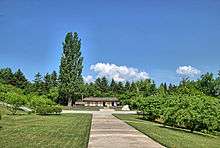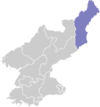Hoeryong
| Hoeryong 회령시 | |
|---|---|
| Municipal City | |
| Korean transcription(s) | |
| • Hanja | 會寧市 |
| • McCune-Reischauer | Hoeryŏng-si |
| • Revised Romanization | Hoeryeong-si |
|
Hoeryong City Centre | |
| Country | North Korea |
| Province | North Hamgyong Province |
| Population | |
| • Total | 134,524 |
Hoeryŏng is a city in North Hamgyŏng Province, North Korea. It is located opposite Jilin Province, China, with the Tumen River in between. Sanhe (三合鎮), in Longjing City, is the closest Chinese town across the river. Hoeryŏng is claimed to be the birthplace of Kim Il Sung's first wife and Kim Jong Il's mother, Kim Jong Suk.[1] It was known as "Kainei" during Japanese rule.
The Hoeryŏng concentration camp (Kwalliso No. 22) is located 20 kilometres (12 mi) from the city.[2]

History
Hoeryŏng was one of the six post/garrisons (Chosŏngŭl: 육진, Hanja: 六鎭) established under the order of Sejong the Great of Joseon (1418 - 1450) to safeguard his people from the potentially hostile semi-nomadic Jurchens living north of the Yalu river.
In early May 2007, the newly appointed Prime Minister Kim Yong-il visited Hoeryŏng. At the time, the Prime Minister brought with him on his train, one carriage worth of glass (made in South Korea) and 3 carriages worth of cement. After delivering the goods to the People’s Committee of Hoeryŏng he ordered that the city of Hoeryŏng be decorated and adorned as much as a city where Mother Kim Jong Suk’s birthplace should be.
Later that month, there was a public protest in Hoeryŏng, the first in recent history anywhere in North Korea. A guard named Ahn Myong-chol was forced to leave Hoeryŏng concentration camp, for the safety of his family, when someone caught him giving food to one of the prisoners in the concentration camp.[3]
On the 22 June 2007, a source reported that a public trial was held at a City Stadium in Hoeryŏng, against 15 human traffic suspects and 4 of them were sentenced to death following a period of starvation; with others reported to have defected to the South.
Administrative Divisions
Hoeryŏng-si is divided into 19 tong (neighbourhoods) and 28 ri (villages):
|
|
Economy
Hoeryŏng's main industries are mining machines and a paper mill. The area contains many mines.
Civil unrest
It is reported that on 24 September 2008 only about 20% of Hoeryŏng's city residents attended a civilian defence-training programme held in Hoeryŏng City. The other 80% are thought to have stayed home or tended to private patch fields. As punishment, authorities from the Civilian Defence ordered non-attendees to pay KP₩5,000, however this fine was largely ignored.[4]
See also
Notes
- ↑ "Brilliant life of Kim Jong Suk". KCNA. Retrieved 2006-06-28.
- ↑ "Kwan-li-so No.22 Haengyŏng (Hoeryŏng)". Wikimapia. Retrieved June 18, 2012.
- ↑ http://www.nautilus.org/fora/security/06107Lankov.html
- ↑ North Korea Today, No. 28. (2008). Research Institute for North Korean society.
Further reading
- Dormels, Rainer. North Korea's Cities: Industrial facilities, internal structures and typification. Jimoondang, 2014. ISBN 978-89-6297-167-5
External links
| Wikimedia Commons has media related to Hoeryong. |
- Hoeryong City picture album at Naenara
- Location of the four forts and the six posts
- (Korean) In Korean language online encyclopedias:
- City profile of Hoeryong
Coordinates: 42°26′N 129°45′E / 42.433°N 129.750°E
